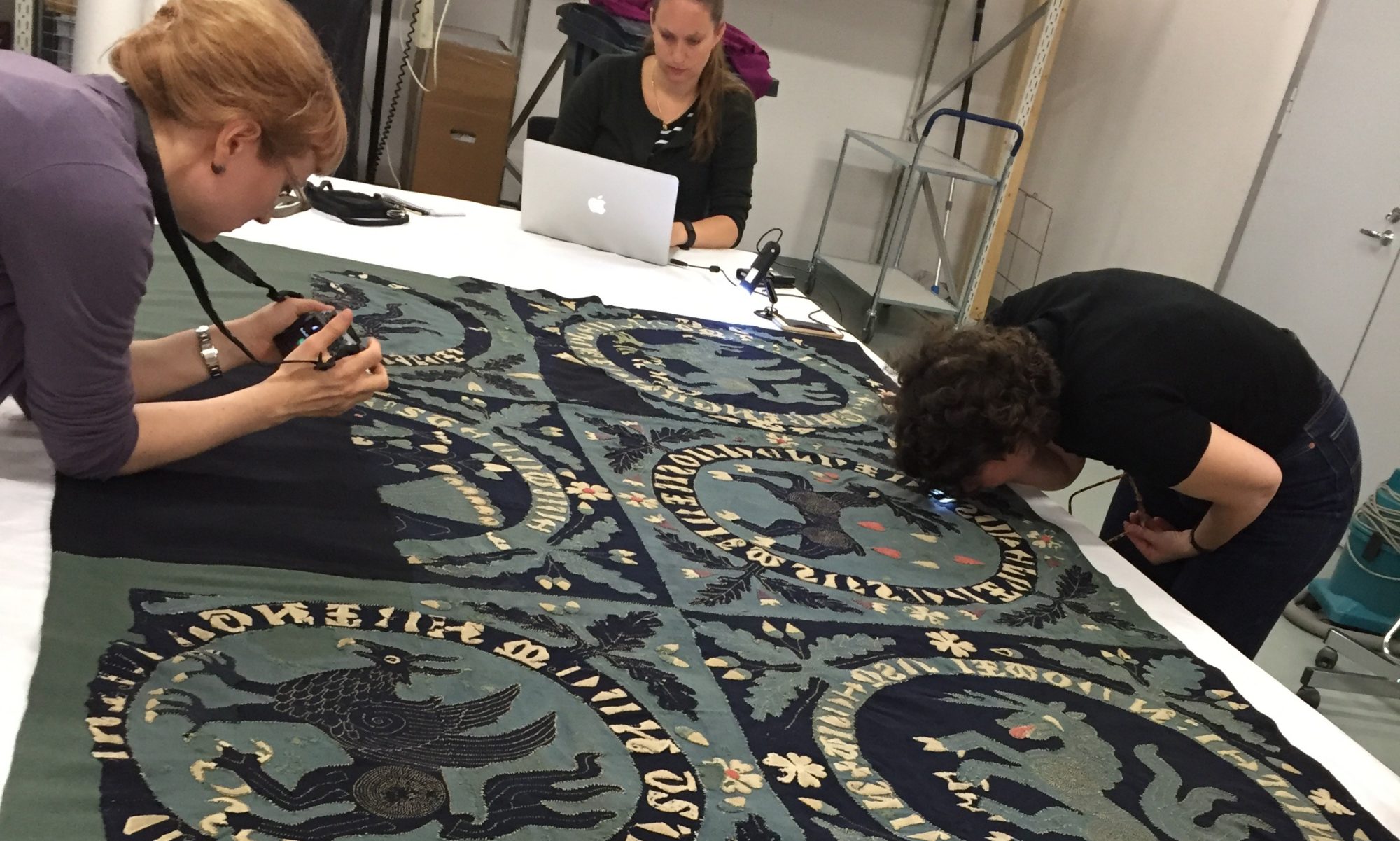
Sitä luulisi että koko kesä on mennyt tapahtumissa rillutellessa, mutta on käsitöitäkin tullut tehtyä. Kirjonta on oiva kesäpuuha, koska toisin kuin esimerkiksi pukujen ompelu, se ei edellytä villakasan keskellä istumista.
Olen jatkanut tammikuussa aloittamaani isohkoa pussukkaa. Siinä on vielä tekemistä, mutta ainakin puoliväli alkaa häämöttää. (Osa kirjonnasta on kierretty kehyksen kiertyvän osan avulla rullalle.) Olisi kiva päästä jo viimeistelemään. Aion tehdä tupsut kesällä värjätystä langasta, lisäksi pussia varten on varattu metkoja luisia helmiä, jotka ostin Kööpenhaminan museokaupasta. En ole vielä päättänyt, millä kankaalla sen vuoraisin. Suosituksia?
Pussin malli löytyy täältä, jos joku haluaa aloittaa samanlaisen.
Pienessä kehyksessä tulee pieni pussukka, jonka esikuvan näin viime syksyllä Lontoossa. Se valmistuu fantastisessa minikehyksessä, joka kulkee mukana käsilaukussa. Elokuussa töissä on ollut kovasti matkustamista ja kokoustamista, joten kätevä matkakäsityö on tullut tarpeeseen. Isoon työhön verrattuna pikkupussi etenee ihanan nopeasti. Pikkukehys on Englannista, kirjontavälineistöä harrastavan kaverini tilaama.
Pussin malli löytyy täältä. Kuvio on tosi helppo ja suosittelisinkin sitä lämpimästi ensikirjonnaksi.
Tässä vielä isommaksi klikattavat lähikuvat kuvioista, siltä varalta että jotakin kiinnostaa.
Nämä kirjonnat on tosiaan muuten tehty villalangalla, toisin kuin alkuperäiset silkkiset. Ajattelin ensin harjoitella vähän halvemmilla materiaaleilla. Näiden jälkeen olisi ehkä silkin aika.
Itse pidän ainakin toisten vaiheessa olevien kirjontojen tarkastelusta: erityisen hauskaa on huomata, miten eri tavoilla työt etenevät. Toiset tekevät ensin kuvion reunat ja täyttävät sitten loput, toiset tekevät yhtä väriä kerralla paljon ja toiset rakentavat työtä kaikilla väreillä vähitellen.
Itse olen tätä jälkimmäistä koulukuntaa, koska se jotenkin tuntuu luontevimmalta ja tietenkin malttamattomana ihmisenä haluan nähdä valmista pintaa mahdollisimman pian. Valitsen yleensä aina jonkun selkeän kuvion ”ankkuriksi”, jonka teen ja sen jälkeen ”väritän” loput sen ympärille. Miten keskiajan kirjojat etenivät työssään, sitä en tiedä. Veikkaisin, että kukin teki tyylillään, vaikka laskettu työ olikin mallien puolesta laajalle levinnyttä. On kiehtovaa ajatella, että Englannista ja Saksasta on löydetty samalla mallilla tehdyt työt.
***
One would think that all summer has been spent carousing at events, but I have also worked on projects! Embroidery is an excellent summer pastime: it travels light and well and it doesn’t require sitting in a big pile of wool.
On my big frame, I’ve been working on and off on the pouch I started in January. There’s still quite a bit to go, but I think I’m about halfway there. (Parts of the embroidery have been rolled around the rotating part of the frame). I’m anxious to finish the pouch, since I have tempting plans: tassels made of the yarn we dyed this summer and some really neat bone beads I got at the museum in Copenhagen. I’m still not quite decided on what to line it with. Any suggestions?
The pattern is here if you’d like to make your own.
On the little frame, I’m making a little pouch I had the pleasure to see in real life in London. I love the little frame, which comes with me everywhere in my handbag. I’ve had to travel quite a bit and attend meetings and seminars and stuff lately, so a handy small project has been perfect. Compared to the bigger purse, the small pouch is progressing quickly. The splendid miniframe is from England, ordered for me by a friend who specializes in embroidery gear.
The pattern is available here. It’s very nice and simple, so something I’d definately recommend as a first pattern to try out.
These are made with wool, btw. I decided to practice a bit on cheaper materials first before moving onto silk like on the extant originals. After these, I think I’m ready to do one in silk.
Some more pics to see the pattern for those who are interested (see thumbnails above). I at least enjoy watching other people’s embroideries in progress. I think it is fascinating to see the different ways in which people work. Others do the outlines first, then fill them in. Others apply one color at a time and some build up the pattern using all colors as they go.
I’m an use-all-colours-as-I-go kind of girl. It felt natural to me and being an impatient person, I like to see a finished embroidery surface sooner rather than later. I pick a clear shape to ”anchor” the rest of the pattern, make the anchor and then ”colour” in the rest of the pattern around it until it’s time for the second anchor. And build it up from there.
I don’t know in which way the medieval embroiderers made their progress, although I could guess they also picked a technique that felt good personally.
One fascinating detail I think about when working on these is how the patterns spread internationally already in the middle ages (just like they do now, although electronically). The same pattern has been found at least on extant textiles in both Germany and England.




